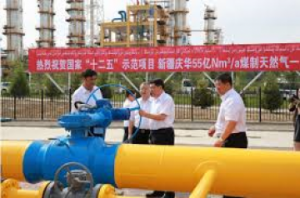 The rush to SNG promises cleaner air for the cities in the east, but threatens water supplies and boosts GHG emissions.
The rush to SNG promises cleaner air for the cities in the east, but threatens water supplies and boosts GHG emissions.
Governing the use of energy and natural resources is a complex task. In seeking to address one problem, you create another problem. The promotion of biofuel use in one country can cause the destruction of forests in another. Requiring power plants to remove sulphur dioxide from their emissions causes them to burn more coal and thus drive up carbon emissions. China faces a similar dilemma as it promotes the production of synthetic natural gas (SNG) made from coal.
In the early years of this century, China’s main energy challenge was to ensure a sufficient supply of energy to support soaring economic growth. Over the last few years two things have changed. First, economic growth has slowed, reducing the pressure on the energy supply chain. Second, air pollution has such reached levels that it has become a major political issue. In response, the government has placed greater emphasis on enhancing the use of natural gas. The construction of liquefied natural gas import terminals is being accelerated, and new deals are being struck to import gas by pipeline from Central Asia and, possibly, from Russia. At home, the government has raised gas prices in order to stimulate the extraction of natural gas and has provided additional subsidies for coal-bed methane and shale gas.
The problem with these policies to boost the supply of gas is that the timing and scale of the additional supply is unpredictable. Most of China’s natural gas resources occur in technically difficult geological conditions which increase the costs and prolongs the time needed to bring gas fields into production. In December 2013, for example, Chevron and PetroChina had to delay yet again the start of production from a major gas field in Sichuan Province, and coal-bed methane is only now starting to make a significant contribution to supplies after more than 20 years of trials. In contrast, SNG is manufactured from coal which is readily available across many parts of the country. If the coal mine already exists, all that is required is to build the gasification plan and a new supply of ‘clean’ natural gas becomes available.
China’s first two SNG plants started commercial production in December 2013. The first phase of Xinjiang Kingho’s plant in Yili, in the far west of Xinjiang, has a capacity of 1.4 billion cubic metres per year which will rise to 5.5 billion cubic metres. In Inner Mongolia, Datang Power’s Keqi plant has a similar initial capacity and a final capacity of 4 billion cubic metres. Sinopec is constructing an 8 billion cubic metres SNG plant near Urumqi city in Xinjiang, whilst Guanghui Energy is looking for a partner to fund a 4 billion cubic metres in the far north of Xinjiang. Sinopec is also planning to build a pipeline to carry SNG from Xinjiang to where it is needed in the east of the country.
The government has set an annual production target for SNG of 15-18 billion cubic metres by 2015 and hopes for 55 billion cubic metres by 2020. Whilst this may be difficult to meet, there is no doubting the current determination to push forward with this way of making gas in order to provide energy which is seen as being cleaner than coal. It is reported that projects amounting to an aggregate annual capacity of at least 40 billion cubic metres have already received approval. Companies are keen to invest and in some cases receive subsidies from local governments.
Despite its apparent promise to solve the country’s energy supply and air pollution problems, SNG suffers from two major problems, as has been pointed out by numerous commentators over the last year. First, using currently available technologies the production of SNG requires large amounts of water, but most of China’s remaining coal reserves lie in the very dry north and north-west regions. As a consequence, large-scale production of SNG will exacerbate existing water shortages. Second, the greenhouse gas emissions from the manufacture of SNG are several times higher than for conventional natural gas. If the SNG is used to generate electricity, these emissions are significantly higher than for modern coal-fired power stations.
These two forms of environmental damage are in direct contradiction with two of the government’s current policy priorities: to manage water supplies more effectively and to constrain the rise of greenhouse gas emissions. The challenge for the government is to find a way to balance (1) the desire to supply clean energy to the urbanised east of the country with (2) the costs to the water supplies in the north and west where SNG is produced and the impact of global climate change. Whilst it is possible that Beijing will pursue its SNG policy regardless of cost, its decision several years ago to restrain the pace of construction of coal-to-liquids plants shows that the government is mindful of the environment consequences of its energy strategies.
Whilst it is certain that a number of new SNG plants will be constructed, a key factor which may determine how the government views the SNG industry will be the rate at which new natural gas supplies can be delivered, whether they be as LNG, through pipelines from Central Asia or Russia, or as shale gas. From this perspective, we must hope that Russia and China conclude their long drawn-out negotiations soon and that shale gas proves to be a success.

